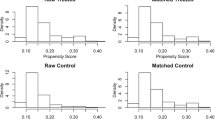Abstract
Background
Seroma/hematoma formation is the most common postoperative complication after laparoscopic inguinal hernia repair. The occurrence of seroma/hematoma remains unclear. The aim of this study was to determine the risk factors for seroma/hematoma formation after transabdominal preperitoneal patch plasty (TAPP).
Methods
The study enrolled 359 groin hernia patients treated by TAPP at Kumamoto Medical Center between 2014 and 2019. The primary outcome was risk factors for postoperative seroma/hematoma formation after TAPP. The secondary outcomes included recurrence of hernia, postoperative complications, and hospital stay.
Results
Among the 359 patients, the incidence rate of seroma/hematoma was 16% (n = 69 patients), and the recurrence rate was 0.3% (n = 1 patient, both sides). In total, there were 452 lesions. Japan Hernia Society (JHS) type II was present in 23% (n = 106) of the total cases but was significantly more common in the postoperative seroma/hematoma group (40%; P = 0.0082). Meanwhile, JHS type I-3 comprised 27% of the total JHS type I group but was significantly higher in the postoperative seroma/hematoma JHS type I group (40%; P = 0.016). Compared with JHS type I, the multivariable odds ratio for postoperative seroma/hematoma formation in JHS type II was 2.77 (95% CI 1.54–4.95). Compared with JHS grade 1/2, the multivariable odds ratio for postoperative seroma/hematoma formation in JHS grade 3 was 2.27 (95% CI 1.28–4.03).
Conclusions
Internal inguinal hernia and hernia size ≥ 3 cm were considered risk factors for postoperative seroma/hematoma formation after TAPP.
Similar content being viewed by others
References
Bittner R, Arregui ME, Bisgaard T, Dudai M, Ferzli GS, Fitzgibbons RJ et al (2011) Guidelines for laparoscopic (TAPP) and endoscopic (TEP) treatment of inguinal hernia [International Endohernia Society (IEHS)]. Surg Endosc 25(9):2773–2843
Li J, Gong W, Liu Q (2019) Intraoperative adjunctive techniques to reduce seroma formation in laparoscopic inguinal hernioplasty: a systematic review. Hernia 23(4):723–731
Pokorny H, Klingler A, Schmid T, Fortelny R, Hollinsky C, Kawji R et al (2008) Recurrence and complications after laparoscopic versus open inguinal hernia repair: results of a prospective randomized multicenter trial. Hernia 12(4):385–389
Abbas AE, Abd Ellatif ME, Noaman N, Negm A, El-Morsy G, Amin M et al (2012) Patient-perspective quality of life after laparoscopic and open hernia repair: a controlled randomized trial. Surg Endosc 26(9):2465–2470
Picchio M, Lombardi A, Zolovkins A, Mihelsons M, La Torre G. Tension-free laparoscopic and open hernia repair: randomized controlled trial of early results. World J Surg 1999;23(10):1004–7; discussion 8–9.
Lau H (2005) Fibrin sealant versus mechanical stapling for mesh fixation during endoscopic extraperitoneal inguinal hernioplasty: a randomized prospective trial. Ann Surg 242(5):670–675
Tamme C, Garde N, Klingler A, Hampe C, Wunder R, Kockerling F (2005) Totally extraperitoneal inguinal hernioplasty with titanium-coated lightweight polypropylene mesh: early results. Surg Endosc 19(8):1125–1129
Kockerling F, Bittner R, Adolf D, Fortelny R, Niebuhr H, Mayer F et al (2018) Seroma following transabdominal preperitoneal patch plasty (TAPP): incidence, risk factors, and preventive measures. Surg Endosc 32(5):2222–2231
Matsumoto R, Nagahisa Y, Hashida K, Yokota M, Okabe M, Kawamoto K (2018) Strangulated hernia can be a risk factor of seroma following laparoscopic transabdominal preperitoneal repair. Minim Invasive Surg 2018:6528075
Bittner R, Montgomery MA, Arregui E, Bansal V, Bingener J, Bisgaard T et al (2015) Update of guidelines on laparoscopic (TAPP) and endoscopic (TEP) treatment of inguinal hernia (International Endohernia Society). Surg Endosc 29(2):289–321
Bittner R, Schmedt CG, Schwarz J, Kraft K, Leibl BJ (2002) Laparoscopic transperitoneal procedure for routine repair of groin hernia. Br J Surg 89(8):1062–1066
Leibl BJ, Schmedt CG, Kraft K, Ulrich M, Bittner R (2000) Scrotal hernias: a contraindication for an endoscopic procedure? Results of a single-institution experience in transabdominal preperitoneal repair. Surg Endosc 14(3):289–292
Reddy VM, Sutton CD, Bloxham L, Garcea G, Ubhi SS, Robertson GS (2007) Laparoscopic repair of direct inguinal hernia: a new technique that reduces the development of postoperative seroma. Hernia 11(5):393–396
Usmani F, Wijerathne S, Malik S, Yeo C, Rao J, Lomanto D (2020) Effect of direct defect closure during laparoscopic inguinal hernia repair (“TEP/TAPP plus” technique) on post-operative outcomes. Hernia 24(1):167–171
Li J, Zhang W (2018) Closure of a direct inguinal hernia defect in laparoscopic repair with barbed suture: a simple method to prevent seroma formation? Surg Endosc 32(2):1082–1086
Pini R, Mongelli F, Proietti F, Cianfarani A, Garofalo F, Di Giuseppe M, et al. Suture and fixation of the transversalis fascia during robotic-assisted transabdominal preperitoneal hernia repair to prevent seroma formation after direct inguinal hernia repair. Surg Innov 2020:1553350620960976.
Tamme C, Scheidbach H, Hampe C, Schneider C, Kockerling F (2003) Totally extraperitoneal endoscopic inguinal hernia repair (TEP). Surg Endosc 17(2):190–195
Tetik C, Arregui ME, Dulucq JL, Fitzgibbons RJ, Franklin ME, McKernan JB, et al. Complications and recurrences associated with laparoscopic repair of groin hernias. A multi-institutional retrospective analysis. Surg Endosc 1994;8(11):1316–22; discussion 22–3.
HerniaSurge G (2018) International guidelines for groin hernia management. Hernia 22(1):1–165
Acknowledgements
The authors thank Alison Sherwin, PhD, from Edanz Group (https://en-author-services.edanz.com/ac) for editing a draft of this manuscript.
Disclosures
Drs. Atsushi Morito, Keisuke Kosumi, Tatsuo Kubota, Shinsei Yumoto, Takashi Matsumoto, Kosuke Mima, Mitsuhiro Inoue, Takao Mizumoto, Nobutomo Miyanari, and Hideo Baba have no conflicts of interest or financial ties to disclose.
Author information
Authors and Affiliations
Corresponding author
Additional information
Publisher's Note
Springer Nature remains neutral with regard to jurisdictional claims in published maps and institutional affiliations.
Rights and permissions
About this article
Cite this article
Morito, A., Kosumi, K., Kubota, T. et al. Investigation of risk factors for postoperative seroma/hematoma after TAPP. Surg Endosc 36, 4741–4747 (2022). https://doi.org/10.1007/s00464-021-08814-2
Received:
Accepted:
Published:
Issue Date:
DOI: https://doi.org/10.1007/s00464-021-08814-2




